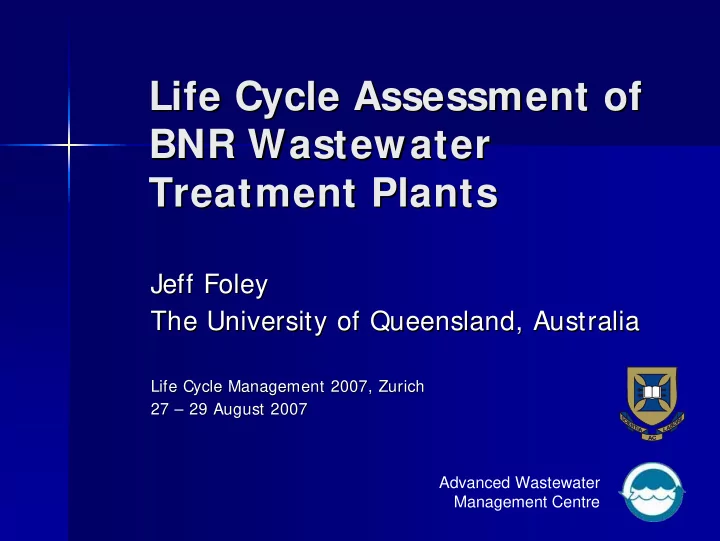

Life Cycle Assessment of Life Cycle Assessment of BNR Wastewater BNR Wastewater Treatment Plants Treatment Plants Jeff Foley Jeff Foley The University of Queensland, Australia The University of Queensland, Australia Life Cycle Management 2007, Zurich Life Cycle Management 2007, Zurich 27 – – 29 August 2007 29 August 2007 27 Advanced Wastewater Management Centre
Presentation Outline Presentation Outline Background Background 1. 1. Goal and Scope Goal and Scope 2. 2. Life Cycle Inventory Analysis Life Cycle Inventory Analysis 3. 3. Life Cycle Impact Assessment Life Cycle Impact Assessment 4. 4. Interpretation and Conclusions Interpretation and Conclusions 5. 5.
Background Background � Initially, WWT about protecting public health Initially, WWT about protecting public health � � 1960s 1960s – – developed biological nutrient removal developed biological nutrient removal � � Today Today – – BNR capable of TN< 3, TP< 1 BNR capable of TN< 3, TP< 1 � � Quality of local water bodies has become community Quality of local water bodies has become community � and regulatory priority and regulatory priority � No quantitative measure of environmental impacts No quantitative measure of environmental impacts � associated with compliance associated with compliance
LCA Goal and Scope LCA Goal and Scope � Quantitatively evaluate 34 WWT scenarios Quantitatively evaluate 34 WWT scenarios � – 8 different configurations – 8 different configurations � Primary sedimentation + anaerobic digestion Primary sedimentation + anaerobic digestion � � Activated sludge & Nitrifying activated sludge Activated sludge & Nitrifying activated sludge � � 3 nitrification 3 nitrification- -denitrification / phosphorus removal designs denitrification / phosphorus removal designs � � Membrane bioreactor Membrane bioreactor � � Anaerobic treatment + post Anaerobic treatment + post- -treatment for nutrient removal treatment for nutrient removal � – Wide range of effluent qualities Wide range of effluent qualities – � From TN< 50 to TN< 3 From TN< 50 to TN< 3 � � From TP< 12 to TP< 1 From TP< 12 to TP< 1 �
50 Do Nothing 45 Primary Treatment + Anaerobic Digestion 40 Activated Sludge + Anaerobic Digestion 35 30 Nitrification + Anaerobic Digestion Effluent Total 25 Nitrogen TN < 20 mg/L (mg/L) 20 15 TN < 10 mg/L 10 TN < 5 mg/L 5 TN < 3 mg/L 0 No TP Target PST + MLE + Anaerobic Digestion Oxidation Ditch TP < 5 mg/L 5-Stage Bardenpho Membrane Bioreactor (MBR) TP < 1 mg/L EnRec + 5-Stage Bardenpho
LCA Goal and Scope LCA Goal and Scope � Functional Unit Functional Unit – – 10 ML/d for 15 years 10 ML/d for 15 years �
Life Cycle I nventory Life Cycle I nventory � Scenario desktop design: Scenario desktop design: � ™ biological simulation package & proven engineering BioWin ™ – BioWin – biological simulation package & proven engineering design methods design methods � Operating phase inventory: Operating phase inventory: � – Biosolids Biosolids – – Energy and chemical consumption – Energy and chemical consumption – Atmospheric emissions Atmospheric emissions – � Construction phase inventory Construction phase inventory � – Based on Eco Based on Eco- -Invent data for Swiss WWTPs Invent data for Swiss WWTPs –
I MPACT 2002+ Life I MPACT 2002+ Life Cycle I mpact Assessment Cycle I mpact Assessment
I MPACT 2002+ I MPACT 2002+ � Aquatic Eutrophication Aquatic Eutrophication � – Primary oxygen consumption in nitrification – Primary oxygen consumption in nitrification – Assume 50% N – Assume 50% N- -limited / 50% P limited / 50% P- -limited limited – No damage modelling to Ecosystem Quality – No damage modelling to Ecosystem Quality � 100 year horizon for GWP 100 year horizon for GWP � � Fate and exposure modelling based on European Fate and exposure modelling based on European � conditions conditions � Results normalised against estimated Australian Results normalised against estimated Australian � environmental profile environmental profile
Unweighted Mid- -Point Point Unweighted Mid Assessment Assessment
Weighted Mid- -Point Point Weighted Mid Assessment Assessment
Unweighted Damage Unweighted Damage Assessment Assessment
I nterpretation & Summary I nterpretation & Summary � Quantitative comparison of environmental costs of Quantitative comparison of environmental costs of � different WWT technologies and standards different WWT technologies and standards � Broad environmental trade Broad environmental trade- -off for advanced off for advanced � nutrient removal nutrient removal local water quality over – Only justified by implicitly valuing Only justified by implicitly valuing local water quality over – all other global environmental pressures all other global environmental pressures � Primary anaerobic treatment, with energy recovery: Primary anaerobic treatment, with energy recovery: � – Better environmental outcomes than Better environmental outcomes than “ “leading edge leading edge” ” BNR BNR – – Even where importation of chemicals is necessary to Even where importation of chemicals is necessary to – improve nutrient removal. improve nutrient removal.
Acknowledgements Acknowledgements � Advisors: Advisors: � – A/Prof. Paul Lant A/Prof. Paul Lant – – Adjunct Prof. Ken Hartley Adjunct Prof. Ken Hartley – – Dr David de Haas Dr David de Haas – � Funding: Funding: � – Queensland State Government Queensland State Government – � Questions..? Questions..? �
Recommend
More recommend